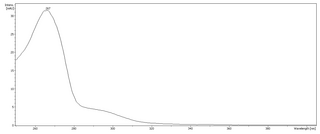Polyketides are a class of natural products derived from a precursor molecule consisting of a chain of alternating ketone (or reduced forms of a ketone) and methylene groups: (-CO-CH2-). First studied in the early 20th century, discovery, biosynthesis, and application of polyketides has evolved. It is a large and diverse group of secondary metabolites caused by its complex biosynthesis which resembles that of fatty acid synthesis. Because of this diversity, polyketides can have various medicinal, agricultural, and industrial applications. Many polyketides are medicinal or exhibit acute toxicity. Biotechnology has enabled discovery of more naturally-occurring polyketides and evolution of new polyketides with novel or improved bioactivity.

Phloroglucinol is an organic compound with the formula C6H3(OH)3. It is a colorless solid. It is used in the synthesis of pharmaceuticals and explosives. Phloroglucinol is one of three isomeric benzenetriols. The other two isomers are hydroxyquinol (1,2,4-benzenetriol) and pyrogallol (1,2,3-benzenetriol). Phloroglucinol, and its benzenetriol isomers, are still defined as "phenols" according to the IUPAC official nomenclature rules of chemical compounds. Many such monophenolics are often termed "polyphenols" by the cosmetic and parapharmaceutical industries, which does not match the scientifically accepted definition.

Gingerol ([6]-gingerol) is a phenolic phytochemical compound found in fresh ginger that activates spice receptors on the tongue. It is normally found as a pungent yellow oil in the ginger rhizome, but can also form a low-melting crystalline solid. This chemical compound is found in all members of the Zingiberaceae family and is high in concentrations in the grains of paradise as well as an African Ginger species.
Cerulenin is an antifungal antibiotic that inhibits fatty acid and steroid biosynthesis. It was the first natural product antibiotic known to inhibit lipid synthesis. In fatty acid synthesis, it has been reported to bind in equimolar ratio to b-keto-acyl-ACP synthase, one of the seven moieties of fatty acid synthase, blocking the interaction of malonyl-CoA. It also has the related activity of stimulating fatty acid oxidation through the activation of CPT1, another enzyme normally inhibited by malonyl-CoA. Inhibition involves covalent thioacylation that permanently inactivates the enzymes. These two behaviors may increase the availability of energy in the form of ATP, perhaps sensed by AMPK, in the hypothalamus.
Mycolic acids are long fatty acids found in the cell walls of the Mycolata taxon, a group of bacteria that includes Mycobacterium tuberculosis, the causative agent of the disease tuberculosis. They form the major component of the cell wall of mycolata species. Despite their name, mycolic acids have no biological link to fungi; the name arises from the filamentous appearance their presence gives mycolata under high magnification. The presence of mycolic acids in the cell wall also gives mycolata a distinct gross morphological trait known as "cording". Mycolic acids were first isolated by Stodola et al. in 1938 from an extract of M. tuberculosis.

Surfactin is a cyclic lipopeptide, commonly used as an antibiotic for its capacity as a surfactant. It is an amphiphile capable of withstanding hydrophilic and hydrophobic environments. The Gram-positive bacterial species Bacillus subtilis produces surfactin for its antibiotic effects against competitors. Surfactin showcases antibacterial, antiviral, antifungal, and hemolytic effects.

Fatty acid synthase (FAS) is an enzyme that in humans is encoded by the FASN gene.

In molecular biology, Beta-ketoacyl-ACP synthase EC 2.3.1.41, is an enzyme involved in fatty acid synthesis. It typically uses malonyl-CoA as a carbon source to elongate ACP-bound acyl species, resulting in the formation of ACP-bound β-ketoacyl species such as acetoacetyl-ACP.

Cornus officinalis, the Japanese cornel or Japanese cornelian cherry, is a species of flowering plant in the dogwood family Cornaceae. Despite its name, it is native to China and Korea as well as Japan. It is not to be confused with C. mas, which is also known as the Cornelian cherry. It is not closely related to the true cherries of the genus Prunus.
Monolaurin (abbreviated GML; also called glycerol monolaurate, glyceryl laurate, and 1-lauroyl-glycerol) is a monoglyceride. It is the mono-ester formed from glycerol and lauric acid. Its chemical formula is C15H30O4.

Nargenicin is a 28 carbon macrolide with a fused tricyclic core that has in addition a unique ether bridge. The polyketide antibiotic was isolated from Nocardia argentinensis. Nargenicin is effective towards gram-positive bacteria and been shown to have strong antibacterial activity against Staphylococcus aureus, including strains that are resistant to methicillin. It has also been shown to induce cell differentiation and inhibit cell proliferation in a human myeloid leukemia cell line.

Morin is a yellow chemical compound that can be isolated from Maclura pomifera (Osage orange), Maclura tinctoria (old fustic), and from leaves of Psidium guajava (common guava). In a preclinical in vitro study, morin was found to be a weak inhibitor of fatty acid synthase with an IC50 of 2.33 μM. Morin was also found to inhibit amyloid formation by islet amyloid polypeptide (or amylin) and disaggregate amyloid fibers.

Taxifolin (5,7,3',4'-flavan-on-ol), also known as dihydroquercetin, belongs to the subclass flavanonols in the flavonoids, which in turn is a class of polyphenols.

Amentoflavone is a biflavonoid constituent of a number of plants including Ginkgo biloba, Chamaecyparis obtusa (hinoki), Biophytum sensitivum, Selaginella tamariscina, Hypericum perforatum and Xerophyta plicata.
Ecklonia stolonifera is a brown alga species in the genus Ecklonia found in the Sea of Japan. It is an edible species traditionally eaten in Japan.
Flavaspidic acid may refer to:

Cerevisterol (5α-ergosta-7,22-diene-3β,5,6β-triol) is a sterol. Originally described in the 1930s from the yeast Saccharomyces cerevisiae, it has since been found in several other fungi and, recently, in deep water coral. Cerevisterol has some in vitro bioactive properties, including cytotoxicity to some mammalian cell lines.

Oligostilbenoids are oligomeric forms of stilbenoids. Some molecules are large enough to be considered polyphenols and constitute a class of tannins.

BI 99179 is a selective small molecule inhibitor suitable for the in vivo validation of type 1 fatty acid synthase (FAS) as a therapeutic target for lipid metabolism-related disorders which has been discovered by Boehringer Ingelheim.














